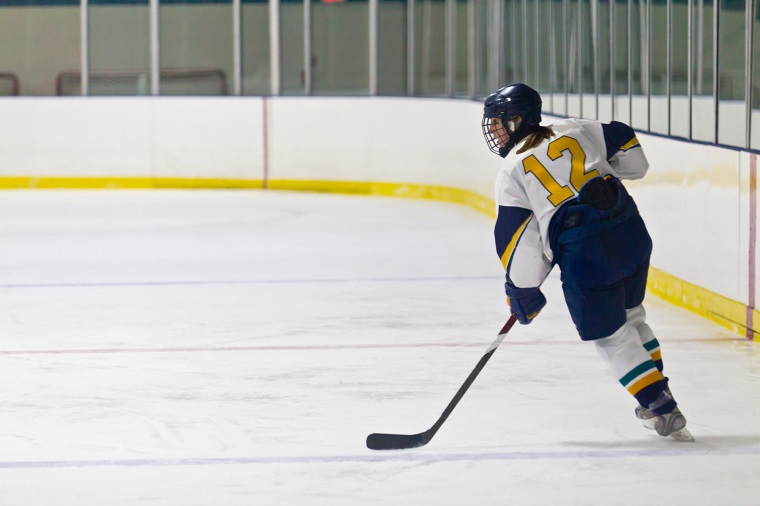Water, Sugar, Salt: A Winning Combination in Hockey
By Madison Wright
15 August 2019

Waiting in anticipation for the puck to drop, hockey players stand ready to put countless hours of training into action. Contrary to what one might expect, some of a hockey player’s most essential game prep actually happens off the ice.
Prof. Lawrence Spriet and graduate student Jessica Bigg in the Department of Human Health and Nutritional Sciences are sports scientists who recently examined sweat loss and hydration in hockey players. Up until now, almost all hydration studies in hockey players have involved males, with little to no research on female players – particularly those playing at a more elite level.
Determined to investigate this understudied group, Bigg focused her master’s research on sweat loss and hydration during on-ice practices in female hockey players who play at different levels. This led Bigg to recruit players from the Canadian women’s Olympic hockey team, the University of Guelph varsity team and a recreational league in the City of Guelph. In total, there were over 20 players representing each level participating in the study.
For each player, Bigg prepared two bottles of their preferred beverage (one for before practice and one for during practice). With strict instructions to players to drink only from their assigned bottles, Bigg was able to calculate the exact amount of fluid, carbohydrate, and sodium each player consumed.
Bigg’s measurements didn’t stop there. Players also submitted urine samples so that the researchers could determine their hydration state before practice, and they wore sweat patches on their foreheads so that the amount of sodium lost during practice could be analyzed. Finally, players were also weighed before and after the practice.
“It is common for hockey players to lose some weight during practices,” says Bigg. “But if they lose anything more than approximately 2 percent of their body mass during a practice or game, you start to see performance decreases.”
Bigg and Spriet gathered valuable data from the study, and each player received an individualized report outlining their pre-exercise hydration status, amount of sweat loss, amount of fluid, carbohydrate and sodium consumed, amount of sodium lost, and any changes in body mass during the practice.
“With this report, we are aiming to give players recommendations to help eliminate the risk of excessive dehydration and performance decreases,” says Bigg.
Bigg and Spriet found that the amount of sweat lost was proportional to the level of play, with the Olympic hockey players sweating the most and recreational players sweating the least. Luckily, the more elite athletes also consumed more fluid to compensate for the amount of sweat lost. As a result, none of the athletes tested were at risk of the dreaded 2 percent body mass loss and associated drop in performance.
Interestingly, half of the Olympic players consumed sodium and carbohydrates as part of their fluid intake, compared to only one varsity player and four recreational players.
“We always recommend hockey players consume some carbohydrates, for example sugar, because it is necessary fuel for an intense sport like ice hockey,” says Bigg. “Players can also add a bit of sugar to their fluid to help them in the later stages of the game as well as in overtime. This is important not only to fuel your muscles, but your brain as well, so that you can reduce mental fatigue.”
Bigg also notes that it is important to remember that the human body is made of salt water, not just water. “When you are losing sweat, you are also losing salt. Most of the time, it is replaced through the diet, but certain players are ‘high salt sweaters’ who are at risk of losing too much salt during exercise. These athletes need to remember to consume salt as well as fluid.”
Because players want to perform at their absolute best during a game, Bigg and Spriet also examined hydration habits and sweat loss in a game setting. Not surprisingly, they found that the players sweat a lot more during a game compared to practice, most likely due to the increased intensity and demands of game play.
Overall, Bigg believes that for the most part, female hockey players have good hydration habits and are very aware of their hydration status. “My advice would be to continue doing what they are doing,” she says.
For those of us who won’t be lacing up for the next Olympics but still enjoy the occasional on-ice skirmish, Bigg says it is easy to monitor your own hydration to determine if you are losing too much body mass or becoming too dehydrated.
“If you weigh yourself before and after exercise, you can calculate if you are close to the 2 percent body mass loss and you will also have an idea of how much sweat you’ve lost. If you lose a litre of fluid, or about 1 kilogram in body weight, then you know that is how much you need to consume before the next exercise session,” says Bigg.
Read the full study in the International Journal of Sports Medicine.
Read about other CBS Research Highlights.